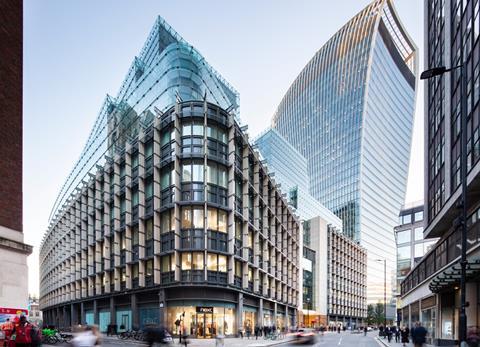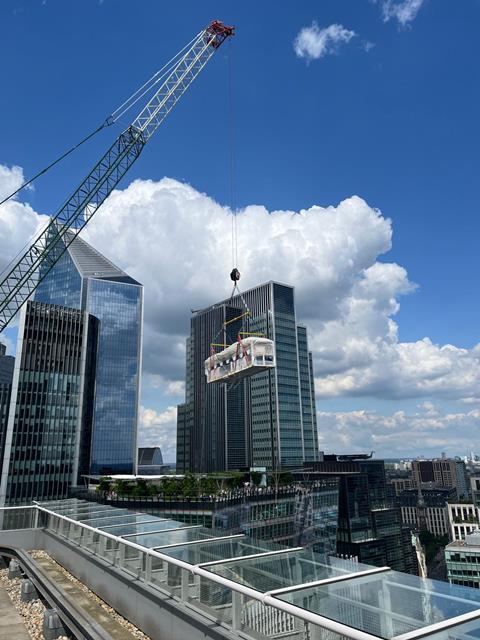Relatively new office buildings right across the world have fast become outdated as occupiers expect greater sustainability credentials. Tom Lowe speaks to one of London’s largest commercial landlords about how it is dealing with the challenge

“It’s the key driver in tenant negotiations,” says Dean Manning. “Sustainability is invariably the top subject.”
The senior vice-president of construction at Brookfield Properties is sitting at a long table in a vast expanse of vacant office space on the 12th floor of 30 Fenchurch Street. It is the only piece of furniture in the room.
One of a dozen assets owned by the firm in the City of London, the location and views are hard to beat. The problem, despite it being completed only 20 years ago, is that it is already outdated in the eyes of the highest paying occupiers.
“It’s up against new ones,” Manning admits, gesturing out of the window at the nearby facades of the City’s eastern cluster of towers. “So what are we doing to make this relevant? How do we give them the same sort of delivery in terms of energy efficiencies, operations, user experience?”

This is the pressing question that Brookfield and other developers and landlords have been facing over the past four years of rapid change in London’s commercial market. What do you do with very expensive assets which, although relatively new, have suddenly found themselves to be behind the times?
The story of the City’s transformation since the covid pandemic is hardly new. Big corporates that were happy to occupy huge gas boiler-heated floor plates without outdoor space or abundant natural light have needed to reassess.
As remote working took off, these employers realised that they needed to offer something more to encourage staff back to their desks. It needed to be about collaboration, wellbeing and, increasingly, company values.
Last year, Brookfield surveyed thousands of office workers to find out what motivated people to work for a particular company. It found bonuses and pay had been replaced by company values as the most appealing asset offered by a potential employer, with the sustainability credentials of a company now topping the list of “deciding factors”.
This followed a series of meetings which Brookfield held with its tenants, many of them large listed companies that were setting science-based carbon reduction targets, to assess what their priorities were in terms of office space.
The feedback we were getting from all of our tenants is that they need very transparent, good data
Conor Storkey, Brookfield Properties
Sitting next to Manning is Conor Storkey, Brookfield Properties’ director of sustainability and environmental, social and governance (ESG) lead. “The feedback we were getting from all of our tenants is that they needed very transparent, good data,” he says. “Tenants are saying that there’s an opportunity for us to support them more on their own sustainability targets and initiatives.”
The result is Accelerate ESG, a programme of data sharing between the landlord and its occupiers aiming to provide clear evidence of progress towards sustainability targets. It is part of a wider initiative that involves the firm upgrading its 5 million sq ft portfolio to reduce operational carbon emissions and align with new requirements for commercial space to achieve an EPC C rating by 2028.
>> Also read: What more can investors and regulators do to help project teams decarbonise buildings?
>> Also read: London towers – does it make more sense to build new or renew?
The flagship scheme is 30 Fenchurch, where the anchor tenant is the £3.6bn turnover UK division of IT consultant Accenture. Designed by Arup and built in 2004, its MEP services are now nearing the end of their 20-year life.
With a like-for-like replacement not considered an option, Brookfield, which purchased the building in 2021 for £635m in one of the biggest office deals of the pandemic, has opted for a comprehensive overhaul.
It has spent £15m stripping out old gas boilers and replacing them with five giant heat pumps, each the size of a lorry, which were lifted 15 storeys from street level by some of the biggest mobile cranes in the world and installed on the roof. The building is now going through a process of transitioning to the new all-electric energy system which is expected to complete by autumn 2025.

The work means a building that had been falling behind its competitors has been “repositioned and is comparable, competitive, relevant, prime grade A space, and all those other good things that we’re looking to do”, says Manning. “It’s that asset by asset opportunity where things come up to be renewed and replaced, that’s really a key part of the big investments that we’re making.”
Fenchurch Street is among the most significant examples of electrification of a large building in London which is in use, with tenants staying in situ throughout the works. This is much more complex than a similar overhaul of 77 Grosvenor Street, a 55,000 sq ft office in Mayfair which is Brookfield’s only asset outside the City. Brookfield bought the 2006 building for around £100m last year and it has vacant possession, allowing works to be carried out much more quickly.
It’s that asset by asset opportunity where things come up to be renewed and replaced, that’s really a key part of the big investments that we’re making
Dean Manning, Brookfield
A bigger challenge in some ways is 100 Bishopsgate, a 40-storey, 786,000 sq ft giant designed by Allies & Morrison in the heart of the City’s eastern cluster. Completed in 2019 by Brookfield-owned contractor Multiplex, it is heated largely by gas with some additional heat pumps.
With the building’s MEP services still at least 15 years off the end of their first lifecycle, there is no obvious opportunity to overhaul the building any time soon. This is a problem faced by swathes of offices across the UK and overseas completed in the years leading up to the pandemic and the changes in working patterns and regulatory requirements for energy performance that followed.
Brookfield insists that this is “not so much an issue” for its occupiers, partly because of a series of interventions the developer has been able to implement to minimise energy consumption. These include new software that modulates how the boilers are turned on and off, reducing energy usage by as much as 20%.
“Although gas boilers still need to be phased out, I think the first step should be trying to drive efficiencies as hard as we can,” says Storkey. “There’s still some pretty big savings you can have with other measures.”

The challenge faced by buildings such as 100 Bishopsgate is illustrated by what has happened to two of the City’s biggest office schemes, 1 Undershaft and and 100 Leadenhall, both of which have been redesigned after securing planning approval to improve their energy efficiency and appeal to deep-pocketed tenants.
>> Also read: ‘We’re too self-effacing’: BCO chief Richard Kauntze on why UK offices are some of the best in the world
>> Also read: Is the City set for a new tower boom?
Then there are the existing buildings that are too difficult to upgrade, a prime example being another of Brookfield’s assets, 99 Bishopsgate. This 1970s building would be demolished to ground level and replaced with a new 54-storey tower designed by RSHP under plans submitted to the City last month.
“The management team there is doing a great job to keep it running, but once you get behind the scenes, you realise it really is hard, in a building of that age, to keep everything running and operating,” says Storkey. “So, from the very beginning, it was a massive consideration of, how do we make this more sustainable?”
The plans involve the retention of the site’s below-ground concrete raft and the proposed reuse of some of the tower’s materials, but of course the redevelopment will still come at a significant embodied carbon cost. In this case, Brookfield says the long-term sustainability of the site became the priority.
“We’re doing everything we can to retain as much as we can and retain as many materials,” Storkey says.
The work being done by Brookfield is one example of how the job of a developer and landlord has been complicated in recent years. It is hard to think of a city better positioned to adapt to the recent changes than London, where the office vacancy rate is currently at around 9%, lower than its main rival New York, where it is closer to 14%, and other cities in the US where vacancy rates are still languishing at 15%, according to real estate analytics group CoStar.
“We’re able to pull on all the good ideas and on all of the initiatives and direction that’s happening in the market,” says Manning. “And I do think London is very prominent in terms of developing new ways forward – design, workplace environments and all those other good things – and I think we’re the front end of that.”


























No comments yet